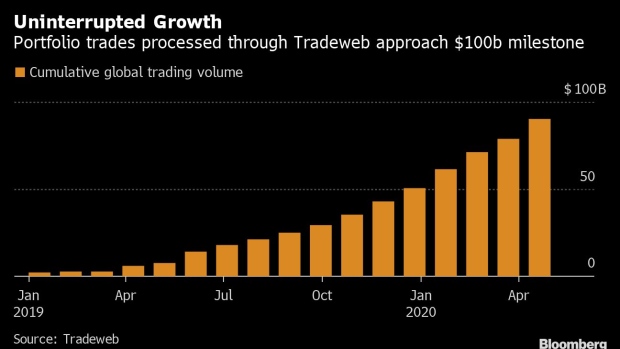Jun 24, 2020
New Bond Trade Beloved by Wall Street Booms Toward $100 Billion
, Bloomberg News

(Bloomberg) -- In the throes of the pandemic panic, more traders turned to a tech-powered tool to price large swaths of corporate bonds in one fell swoop.
Portfolio trading, powered by the ETF boom, was gaining converts as markets in many individual bonds all but froze. Transactions cleared by Tradeweb Markets Inc.’s electronic platform have doubled from a year ago, reaching a cumulative $90 billion globally last month. That’s already more than in all of 2019, and puts Europe on track to surpass Wall Street’s tally from last year, too.
“People who have been observing developments in portfolio trading from the sidelines started getting involved,” said Enrico Bruni, head of Europe and Asia business. His firm processed 54 portfolio trades in Europe in March.
A portfolio trade works by tapping into the growing inventory of bonds held in exchange-traded funds to move a diversified basket of securities in a single transaction. The practice spread even as market players faced mounting obstacles dealing in individual European corporate bonds.
A measure of liquidity costs, the gap between bids for high-yield bonds and ask prices, doubled and remains elevated, despite a broader recovery witnessed in corporate bond indexes and exchange-traded funds.
If necessity is the mother of invention, then the pandemic may help bring the staid corporate bond market into the 21st century, and give its traders the speed and efficiency that’s routine among stock dealers.
The main advantage to portfolio trading is the ability to move entire baskets of bonds in one go, and the prospect of liquidity in a selloff.
“Irrespective of Covid, portfolio trading has been growing at a huge pace and clients prefer it because it saves time, effort and cost,” said Mehmet Mazi, head of debt trading and financing at HSBC Holdings Plc in London.
So-called authorized participants can buy shares in an ETF, redeem them for a basket matching the fund’s characteristics and sell it to a portfolio manager. Conversely, they can buy a basket of bonds from an asset manager and create new shares through the ETF issuer.
“It takes us a few minutes to price up a bucket of more than 500 bonds,” said Mazi. “Without the technology we deployed, it would otherwise take line traders days.”
But shifting single-name bonds may still be better done by humans, especially when they are dealing in a crisis that’s outside of the data set programmed into computers.
Read more: Humans Top Bots in Covid Crisis Electronic Bond Trading Test
And portfolio trades don’t work in a vacuum. At the worst of March’s pandemic-rocked sessions, some banks switched off pricing algorithms, according to Stuart Campbell, head of trading at Bluebay Asset Management LLP, which oversees more than $59 billion.
“On volatile days, those claims go out of the window,” he said. “Portfolio trading is not a silver bullet to the lack of liquidity.”
Tradeweb’s competitor MarketAxess Holdings Inc. said it doesn’t publish data on portfolio trading volumes. Bloomberg LP, the parent company of Bloomberg News, competes with Tradeweb and MarketAxess in providing fixed-income trading services.
The technology isn’t just for sell-side traders trying to execute lightening-fast deals. At London-based Muzinich & Co., fund managers use portfolio trades for complex transactions that combine purchases and sales -- a process that can take up to two weeks and requires human intervention.
“You still make the decision on what should be bought and sold, and transaction costs are cheaper,” said Tatjana Greil Castro, a portfolio manager at Muzinich & Co., which oversees $33.5 billion. “I like it.”
©2020 Bloomberg L.P.





